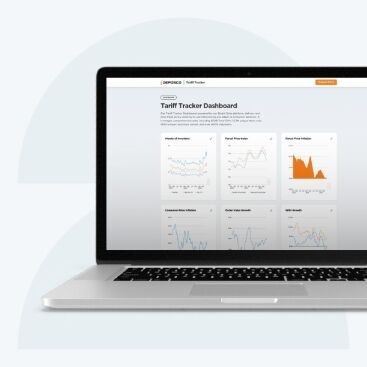When tariffs change overnight, waiting for quarterly reports to reveal the damage isn’t a sustainable strategy. It’s a recipe for failure. Supply chain leaders need tariff impact analysis tools that deliver real-time insights, transforming reactive scrambling into proactive strategy.
Today it’s tariffs. Tomorrow it could be another macro disruption. How will tariffs impact your business? Use Deposco’s real-time Tariff Tracker alongside these actionable insights to navigate whatever is thrown at you.
The critical need for supply chain tariff visibility
Most supply chain leaders operate with limited visibility when tariffs hit. They know rates changed, but can’t answer the critical questions: Which SKUs took the biggest hit? How did this shift affect margins? Should they pivot sourcing immediately or wait it out?
Supply chain tariff visibility can be achieved with modern techniques and tools that help you automatically calculate downstream impacts across operations. Instead of discovering tariff damage in quarterly reviews, leaders can now tap into AI-based intelligence to understand the impact of tariffs and other disruptions, and act accordingly.
Modern businesses require capabilities that help in monitoring tariff changes beyond simple rate tracking; they need comprehensive impact analysis across their entire supply chain network.
Real-time tariff impact tracking: beyond basic rate monitoring
Effective real-time tariff impact tracking requires supply chain execution solutions that integrate tariff schedules with pricing data, inventory levels, and procurement forecasts. When rates change, organizations need instant visibility into which SKUs face the greatest impact and how these shifts affect gross margins across product lines.
Data analytics for businesses transform raw tariff information into actionable business intelligence. The ability to visualize tariff effects on costs in real-time enables organizations to move from reactive cost management to proactive strategic planning.
Explore how Deposco’s Supply Chain Intelligence (SCI) solutions deliver real-time insights into shipping and data executives need to make optimal decisions on the go.
Advanced tracking systems provide granular insights that traditional ERP systems cannot match, offering comprehensive visibility into how policy shifts affect landed costs, inventory valuations, and bottom-line profitability.
Scenario planning tools for strategic decision-making
Effectively monitoring tariff changes requires preparing for multiple potential futures. Advanced scenario planning capabilities enable organizations to model various tariff scenarios, from gradual increases to sudden policy reversals, showing potential impacts and optimal responses.
Sophisticated scenario planning extends beyond simple “what-if” calculations. It requires modeling that accounts for supplier relationships, inventory positioning, and alternative sourcing options. Organizations need tools that integrate with existing procurement and inventory systems, ensuring theoretical models reflect real operational constraints.
When trade policies shift, having concrete action plans ready for immediate implementation provides significant competitive advantage. The most effective scenario planning tools enable leaders to move from abstract planning to actionable strategies.
Complete landed cost analysis for informed sourcing
Traditional supplier comparisons often focus on base product costs, missing the complete landed cost picture that includes tariffs, freight, and other trade-related expenses. This limited visibility can lead to sourcing decisions that appear cost-effective initially but prove expensive in practice.
Comprehensive landed cost analysis requires platforms that automatically update supplier cost comparisons as tariff rates evolve. These systems integrate real-time tariff data with supplier pricing, freight costs, and delivery timelines to provide complete cost visibility.
When tariff rates change, supplier rankings should adjust automatically, highlighting new optimization opportunities. This complete cost visibility enables more informed sourcing decisions and helps identify opportunities for supply chain diversification.
After tariffs surged duty lines 125% in April 2025, businesses are drowning in precautionary inventory. But overstocking is neither sustainable nor competitive. The solution? Smart safety stock optimization that turns chaos into cash flow.
Building transparency in tariff management
Transparency in tariff management requires actionable insights that distill complex data into actionable insights. Effective dashboards highlight key trends, flag emerging risks, and recommend strategic responses rather than overwhelming decision-makers with raw data.
Visual representations of tariff impacts across product lines, geographic regions, and supplier relationships enable quick comprehension of complex situations. The most effective intelligence provides drill-down capabilities, allowing leaders to move from strategic overview to detailed analysis when specific situations require deeper investigation.
How Deposco delivers tariff impact visibility
Did you know Deposco won ‘Supply Chain Visibility Platform Of The Year’ from SupplyTech Breakthrough in 2025?
Deposco’s Bright Suite platform unifies disparate data sources into a single, coherent view of tariff impacts.
By integrating tariff schedules with inventory data, supplier information, and cost structures, the platform delivers comprehensive visibility that enables proactive strategy adjustment.
- Real-time tariff impact tracking around pricing, inventory, and consumer behavior using $50B in transaction data
- Scenario modeling for multiple strategic options
- Automated cost comparisons including landed costs
- Executive dashboards with drill-down analytics
- Integration with 60+ carriers for comprehensive shipping cost analysis
Take action before tariffs take their toll
In today’s volatile trade environment, tariff impact visibility is a competitive necessity. Organizations that can quickly understand policy implications and adjust strategies accordingly will thrive while others struggle to catch up.
